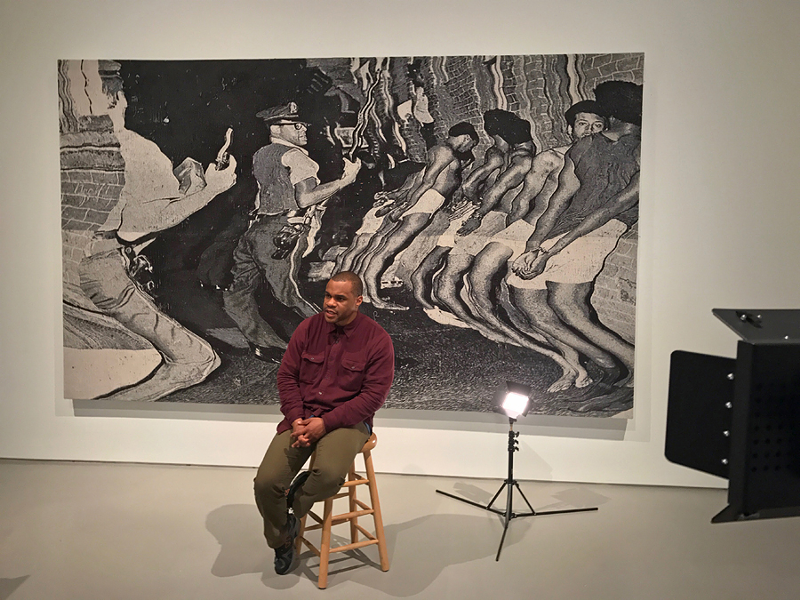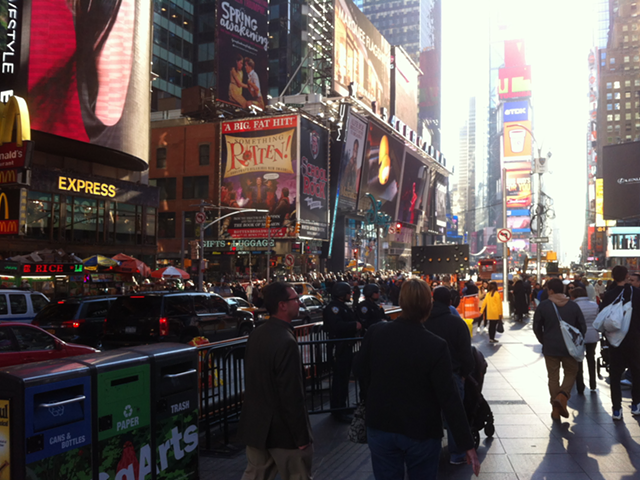
Because Anderson and Bowers work with formal approaches to radical compassion, their shows offer the hope of liberation for those most oppressed in our society. They also call upon us to examine our own role, however passive, in preventing the oppressed from reaching that goal.
Occupying the upper and lower levels of the second-floor galleries through June 18, Anderson’s Blak Origin Moment and Bowers’ Womxn Workers of the World Unite! equally engage with politically charged topics — and this is likely why CAC curator Steven Matijcio paired the two. While Anderson deftly dissects police brutality, rape culture and the limits of socially prescribed black male identity, Bowers tackles issues of trans liberation, labor equity and immigrant rights.
The Louisville, Ky.-born Anderson, a former assistant professor at the University of Cincinnati, has been living in New York and working as a clinical assistant professor of printmaking at New York University since 2015, and Blak Origin Moment marks his first solo museum show and first major show in Ohio. (Miller Gallery in Hyde Park is also showcasing studies for Anderson’s CAC show from Thursday through March 25.)
In a series of poetic gestures, much of Anderson’s work in Blak Origin Moment is translated through a variety of distressed textiles and piled-upon surfaces: digitally produced, chemically and hand-treated jacquard tapestries; erased and subsequently printed-upon pages of Ebony magazine; purposefully besmirched old rugs; and large sheets of dirt-caked roofing rubber.
The implicit centerpiece of the show is Anderson’s monumental tapestry, “die Leitung” (“The Administration”), a distorted, oversized black-and-white digitally reproduced image of a lineup of black men forced to publicly submit to a strip search while armed policemen look on. Like its suggested visual reference, Francisco de Goya’s powerful early-19th-century anti-war statement “The Third of May 1808,” Anderson’s image likewise implicates the viewers as complicit in these acts of violence and urges understanding.
The pieces in Blak Origin Moment feel as haunted by the sins of America’s recent past as the work itself is haunting. Seen within the context of his images of black men, the inclusion in a diptych of a distorted mug shot of convicted white sex offender Brock Turner — the former Stanford University student who was only sentenced to six months in confinement for raping an unconscious young woman — stands as a poignant testimony to ongoing racial inequity.
In a triptych entitled “Escapism (misnamed),” Anderson creates computer-generated portraits that fuse together the faces of three young black men who were killed by police with those of the officers who either shot or choked them to death. Pairing the visages of slain black men Michael Brown, Eric Garner and Cincinnati’s own Samuel DuBose with the portraits of the police officers who killed them requires a kind of empathy on behalf of the viewer.
One must sit with the difficult contradiction of identifying with both perpetrator and victim. In a time when no visit to social media comes without an onslaught of public and private tragedies that provoke a tangible mixture of guilt and anger, Anderson’s works in Blak Origin Moment seem to have a finger on the pulse of our current political climate.
But, to some extent, this is perhaps the point. As the accompanying exhibition text suggests, Anderson’s pieces “evoke moments where racial recognition is heightened,” yet consciously avoid any kind of neat resolution.
Ohio-born, Los Angeles-based Andrea Bowers works at the intersection of art making, social justice and activism, and nothing about Bowers’ work is neutral.
The self-identified white, cisgendered “activist artist” stated during the opening night talk that one of her most important jobs as an artist is to “look at things that have been under-recorded and make them visible.”
To that aim, Bowers mines an archive of feminism, from rare early glimpses of empowered women — in political posters and placards from the late 19th century and the early years of the women’s movement — to contemporary documentations of activists currently working to broaden the scope of inclusion.
The artist also highlights the work of activists who are working at various intersections of social inequality. Bowers creates photo-realist drawings of isolated individuals who marched on behalf of immigrant labor reform on International Workers’ Day in 2011 and were in TransLatina Coalition protests in 2016.
On these intimate images, which require an up-close inspection to realize that they are in fact hand drawn, each subject is positioned near the edges of the page to reflect their marginalized status.
Three life-sized photographic portraits of trans feminist activists and women of color — CeCe McDonald, Johanna Saavedra and Jennicet Gutiérrez — occupy a large section of gallery wall space, and their oversized presence speaks to a need for greater visibility of trans women within the larger women’s movement.
As the artwork throughout both Bowers’ and Anderson’s shows attest, we must first see truth before we can act upon it.
Neither of these shows is easy to “get,” but both artists seduce with gestures that include and implicate the viewer as simultaneous witness and potential conspirator. They’re urging us to see truth.
BLAK ORIGIN MOMENT and WOMXN WORKERS OF THE WORLD UNITE! are on display at the Contemporary Arts Center through June 18. More information: contemporaryartscenter.org.





